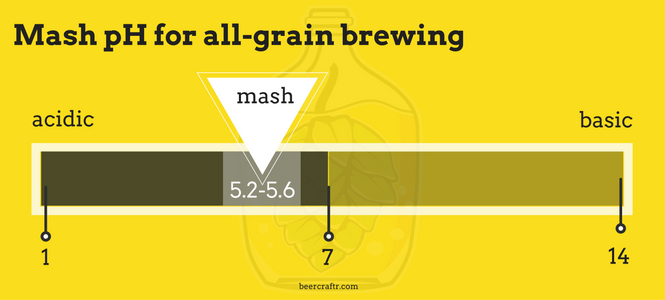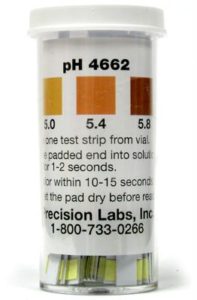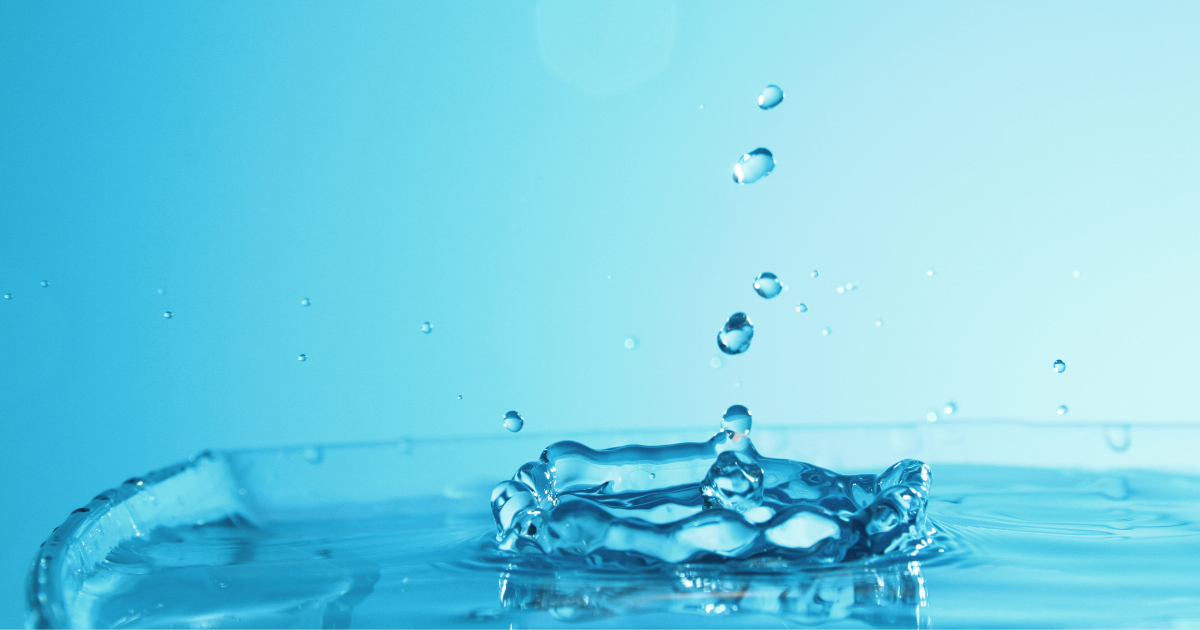If, like me, you started out as an extract brewer, you never had to concern yourself too much with the quality of your water. If it is good enough to drink, it’s good enough to brew with, I was told. But as an all-grain brewer, that maxim is a bit too simplistic for our needs. In truth, water plays a huge role in the quality of our final product, from the very start of the brewing process, through to the final taste. The various minerals and salts we find in water can add desirable or undesirable flavours to our beer. Water plays a crucial role in helping us craft good beer, so we should take the time to better understand it.
Let’s start with mash PH
You may recall from high school chemistry that pH is a measure of how acidic a solution is. pH is measured on a 14-point scale:
- If a solution has a pH of less than 7, it is acidic
- If a solution has a pH of 7, it is neutral
- If a solution has a pH higher than 7, it is basic
Pure water is neutral (pH of 7). Most water actually has a pH level higher than 7, since it contains dissolved minerals. When you mash it with your grains, however, the resulting solution dips down, becoming acidic. Now this part is rather important: The optimal pH level for a mash is between 5.2 and 5.6.

Why do we want the mash pH to be in that range?
- It improves enzyme activity, which means we get better conversion of starches to sugars
- It ensures the final wort has a lower pH, which will help with yeast health during fermentation.
- You’ll get better hop extraction during the boil
- You’ll Better flavour and clarity of beer, especially as the beer ages.
What affects pH in the mash?
In simple terms, the water used, and the malts used will obviously affect your mash pH. Malts are acidic and will naturally lower the pH of your wort, especially darker malts. But we need to understand the chemical composition of water to get a better sense of how it affects pH. Ultimately, we can’t change the acidity of our grains, but we can change the acidity of our resulting solution. To do that, we need a baseline understanding of some of the dissolved molecules that we find in water: cations and anions.
- Cations are molecules with positive charges that can lower your beer’s pH levels. These include calcium, magnesium, sodium, potassium, iron, zinc, and sulphate.
- Anions are molecules with negative charges that can raise your beer’s pH levels. There are really only two anions that we would use in the brewing process: Bicarbonate and chloride. We’ll come back to this in just a moment.
Why pH matters even more for BIAB
As you know, BeerCraftr is a resource for Brew-in-a-bag (BIAB) brewers, and all the recipes on the site are BIAB. I love BIAB for its simplicity, ease, and convenience. However, it does present some elevated risk when it comes to your mash pH.
With traditional mashing, you use a lower water-to-grain ratio of 1.25 quarts water per pound of grain. Additional water is added after the mash—during the sparge—to achieve full pre-boil volume. However, with BIAB, we use a much higher water-to-grain ratio (usually, the full pre-boil volume), to the tune of 300-500% more than a traditional mash. The end result is a higher pH. So, if we want to attain the ideal pH level in our mash, we as BIAB brewers have to take measure our pH levels more than most.
Measuring your mash’s pH levels

Knowing your mash’s pH level can help you troubleshoot problems early in the brewing process. While most beginners don’t need to worry about measuring their mash’s pH levels, if you’re looking to level up your brewing, I highly recommend buying pH strips and taking a pH reading at the end your mash. If your pH levels are too low (or too high), you’ll want to fix it before you get to the boil.
So, make the small investment, and when you brew your next batch, dip the end of the pH strip into your mash and compare the strip’s resulting colour to the scale on the side of the packaging. It’s not as precise as a digital pH meter, but it will give you all the information you need.
Changing your mash’s pH levels
First thing’s first, unless you’re a professional brewer, you should avoid attempts to alter your water’s pH levels before the mash. Remember, it’s the mash pH that matters, and if you start altering your water’s pH before you have a reading from the mash, you may discover that your mash is beyond repair. In truth, you may discover that you rarely, if ever, need to alter your mash’s pH. So, don’t put the cart before the horse.
When it comes to changing your mash’s pH, here are the seven big (and safe!) powerhouses you need to know about:
- Calcium chloride is the best addition you can use to lower the pH (acidify) your wort. It will also accentuate malt and sweetness in your final beer.
- Gypsum can be used to lower the pH of your beer, but this one is best reserved for beer styles that benefit from hard water (those famous Burton IPAs, English Ales, and Irish Stouts). Of note, it will enhance your beer’s bitterness.
- Lactic acid is an organic acid, available in an 88 percent (by weight) pure liquid form from most homebrew stores. Add a drop to lower the pH, stir the mash, and test the pH, that’s usually all you need.
- Acid “Sauermalz” malt is a pilsner malt that has been acidified with lactic acid, to the tune of 3 percent (by weight). You simply replace a percentage of your grain bill with some of this malt to lower the pH. The rough math works out to this: If your grain bill consists of 1 percent of acid malt, it will experience a 0.1 drop in pH. Two percent will drop the pH by 0.2, etc. So, assuming you’re 1 gallon recipe has a 2 lb grain bill, you’d add about 9-10 grams (0.02 lbs) of acid malt.
- “5.2 Stabilizer” will also lower your pH. This is called a “buffer,” in that it won’t let you fine-tune with great precision, but it will get your mash to an optimal pH. So, it is rather convenient and stress-free.
- Baking soda will reliably raise your pH, but will add sodium to the wort. Not necessarily a bad thing if you’re using small quantities, and can help round out the flavours in your beer.
- Chalk is also an option for raising your pH. It’s not as effective as baking soda, but would be more appropriate in cases where you don’t want to add too much sodium to your wort.
While you could sit there and work out highly complex calculations to determine how much of these course-correcting additions you need add to your wort, given the batch size we operate with (1 gallon), the simplest way to alter your mash’s pH is to simply add a very small amount of your preferred fixer, and re-measure the pH level. Treat it as you would salt when seasoning a dish. You an always add more, if needed; but if you overshoot it, it gets tough to balance out the seasoning. So, start with a small dose of your fixer and work your way up, as needed. After one or two brews, you’ll get a sense for the ideal amount. Of course, if this seems all a bit too labour-intensive, nothing stops you from using bottled water from the get-go and foregoing your municipal water supply. If you take that route, you’re unlikely to ever worry about pH levels. You might still want to check you pH from time to time, just for peace-of-mind, and to impress friends and family with your mad chemistry knowledge!
Now, you may have read about home brewers using a variety of molecules to emulate the water profile of their favourite brewing region (sulphates for Burton water, or calcium for authentic Pilsner), but that goes beyond the scope of this guide. Our primary focus in understanding water chemistry, is to ensure we have the right pH levels in our mash. Besides, I’m too lazy to try to emulate water profiles from around the world. I’d rather just brew and pretend I’ve added my own terroir taste!
Before we part, a note on chloramines
In North America, most of our municipal water supply has been sanitized with chlorine. In many more jurisdictions, water is sanitized with chlorine and ammonia, which react to create chloramines. While good for public health, chloramines lend a noticeably unpleasant plastic-like taste to the beer. I happen to live in a city (Toronto) that has this (brewer’s) problem.
Thankfully, there’s an easy solution to this problem (if you don’t feel like lugging bottled water from the grocery store): Campden tablets. These tablets will remove chloramines from the water. You just need to crush the amount you need into a powder and add it to the water. Let it stand for 10 minutes before you heat it up for the mash. Of course, the one draw-back for us small-batch brewers is that even these small tablets go a long way. You only need half a tablet for a 5-gallon batch, 1/4 tablet for a 2.5-gallon batch, and even less for 1-gallon brewing. So, if you don’t feel like taking out the microscale and having your neighbours wonder what kind of lab you’re running as you grind tablets to a fine powder so obsessively, you may want to treat 2.5 to 5 gallons at a time, if you have the room for it. Treat it as your reserve supply of brewing water! Or better yet, brew two or three beers all in one sitting!


Leave a Reply